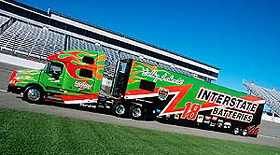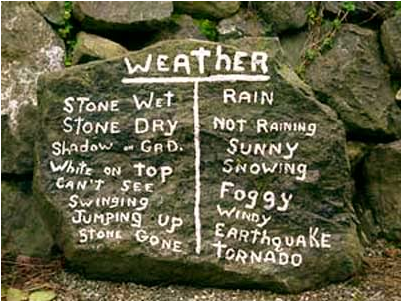Go/No Go Decision
Topic 4641 | Page 1

Mine are easy. If the road is closed I don't go. Road is open I go.

Mine are easy. If the road is closed I don't go. Road is open I go.
I Agree
It all comes down to the golden rule - don't hit anything.
If you're not comfortable driving in certain conditions then don't. I'm from outside of Buffalo, NY so I've spent my entire life driving in heavy snow. The first few years I drove a rig there would be times I would be parked in conditions I probably could have done fine in but it just wasn't worth taking the risk. Later in my career as I developed the skills I was able to drive through almost anything pretty comfortably as long as I could actually see where I was going. That's usually the bigger problem. You can keep the truck on the road if you can see where the road actually is!

But in trucking there really are no guidelines or policies about driving in poor weather other than to say it's at the discretion of the driver. So always play it on the safe side.
Two other things:
1) Never, ever, ever decide you're going to keep driving because other trucks are on the road. You will never find conditions so poor that nobody will give it a shot. There will always be trucks on the road if the road is open, I don't care if it's a hurricane or a blizzard or what. Someone will be out there going for it. Don't let that sway your decision.
2) Practice in the snow. I used to take every opportunity I could find to practice winter driving in large, empty parking lots. You get in a Walmart or closed factory on a night with heavy snow and you might have your own skid pad the size of two football fields all to yourself. I used to do everything I could think of:
- drive in an arc and lock up the trailer brakes
- drive in an arc and mash the gas to get the tractor tires to break loose
- drive around using the gas pedal to make the tractor fishtail around in a circle
....just anything you can think of to get that truck sliding, fishtailing, or jackknifing and then learn to recover from it.
Obviously a huge word of caution here - make 100% certain you're in a safe area to do this. Watch for telephone polls, light polls, and even things like nearby houses where people might get annoyed with the noise you're making in the middle of the night. But finding an area to practice your winter driving skills is huge. I've done it my entire driving life and I still do it to this day. I'll take my big redneck Chevy 4x4 out in snowstorms. I'll drive around town and play around in big, empty lots. I want to test what the truck is capable of and I want to learn how to get it back under control once I start sliding.
I can say with 100% confidence that I avoided several wrecks over the years because I was able to get the truck back under control after it started sliding. If I hadn't practiced winter driving over the years I never would have known how to make the right choices and get that thing back under control.
OOS:
When a violation by either a driver or company is confirmed, an out-of-service order removes either the driver or the vehicle from the roadway until the violation is corrected.
1) Never, ever, ever decide you're going to keep driving because other trucks are on the road. You will never find conditions so poor that nobody will give it a shot. There will always be trucks on the road if the road is open, I don't care if it's a hurricane or a blizzard or what. Someone will be out there going for it. Don't let that sway your decision.
I grew up in snow country and have driven lots of miles in a four-wheeler through snow. I remember one time driving on I-80 through western Nebraska right after a blizzard. Most trucks were stopped at truck stops. There were a few out on the road. We were driving back to Colorado from Iowa, normally about a 12-hour trip, but this time more like 16 hours. My wife was crabby because I was driving about 35 mph on the interstate , and asked why I was driving so slow.
Just as she was b**ching at me, we came around a long, flat curve. There were no fewer than 6 trucks in the very wide median on that curve, including a couple that had rolled, and another 4 or 5 who had pulled off on the right side of the road. I said, "That's why I'm driving so slow." That actually stopped her mouth for a good two hours.
Interstate:
Commercial trade, business, movement of goods or money, or transportation from one state to another, regulated by the Federal Department Of Transportation (DOT).

I consult my WEATHER ROCK:

Only thing that will stop me if the road is Closed. Other than that, I roll through Rain and Snow. I know my limits of my truck and myself. I'll pull over when I need to. No Load is worth dying for.

If I've got Traction, its Go Time!

As a pilot, you already know the answer to your own question: Never second-guess your instincts.
Your stomach will never lie to you. If you have a bad feeling in your gut, consider yourself grounded. Instincts are non-verbalized, highly complex warning-systems built into your psyche and your brain, for your survival.
I have nothing but the utmost respect for everyone who is experienced and skilled in this trade. Because of their skills, these instincts don't pop up as easily when a snowflake falls, as they would for a newbie, because the seasoned drivers already know how far they can push their limits. With time and experience, your fear (and mine) will subside quite a bit - hence the long, long hours of practice in parking lots. But today ... I wouldn't even consider driving a tractor-trailer in the snow. A year from now, my tolerance and skills will grow in proportion to the calm that comes with time and experience. Therefore, the warning instincts will signal less often and less alarmingly, even in more stressful situations. On the other end, like Brett said, you can't drive on what you can't see ...or what you can't maintain control on - and that is probably the upper limit for anyone.
What I'm learning at work is: accept the load, at least try to drive that run, and if you do reach a point where either the roads are closed or you've met your limits, then you can reasonably call in to dispatch and tell them you can't go any further.
-mountain girl


As a pilot, you already know the answer to your own question: Never second-guess your instincts.
Your stomach will never lie to you. If you have a bad feeling in your gut, consider yourself grounded. Instincts are non-verbalized, highly complex warning-systems built into your psyche and your brain, for your survival.
I have nothing but the utmost respect for everyone who is experienced and skilled in this trade. Because of their skills, these instincts don't pop up as easily when a snowflake falls, as they would for a newbie, because the seasoned drivers already know how far they can push their limits. With time and experience, your fear (and mine) will subside quite a bit - hence the long, long hours of practice in parking lots. But today ... I wouldn't even consider driving a tractor-trailer in the snow. A year from now, my tolerance and skills will grow in proportion to the calm that comes with time and experience. Therefore, the warning instincts will signal less often and less alarmingly, even in more stressful situations. On the other end, like Brett said, you can't drive on what you can't see ...or what you can't maintain control on - and that is probably the upper limit for anyone.
What I'm learning at work is: accept the load, at least try to drive that run, and if you do reach a point where either the roads are closed or you've met your limits, then you can reasonably call in to dispatch and tell them you can't go any further.
-mountain girl
You are sooooo right MG. As a pilot I have honed that small voice inside that says "dont go today" Now just have to adjust and hone it for trucking.

You are sooooo right MG. As a pilot I have honed that small voice inside t hat says "dont go today" Now just have to adjust and hone it for trucking.
hat says "dont go today" Now just have to adjust and hone it for trucking.
-HM
Yeah, you have the right stuff, HM. Yer gonna' do great in this.
-mountain girl
New Reply:
New! Check out our help videos for a better understanding of our forum features

















Preview:








 TT On Facebook
TT On Facebook
This is for you experienced peoples out there. How do you, personally, come to your decision to roll, or not, because of weather, vehicle problems,or health reasons?
I dont know how is works in the trucking industry. I DO know how it works in aviation and basically, it works like this. 1. There are FAA weather minimums that must be met. For VFR(Visual Flight Rules) they are pretty simple. 2. There are FBO(Fixed Base Operator-This is where I rent the aircraft) minimums that must be met. An example is no touch and go's below 32 degrees F. Its hard on the engine and you can shock cool the cylinders. 3. There are personal minimums that you, as PIC(Pilot In Command) must develop. Mine were- no flying in less that 3 miles visibility, no landing at any runway shorter that 2500 feet.
So, the DOT and FMSCA have regs on when you can roll and when you cant. I can assume that carriers have their own requirements on top of those. So my question is, what are your personal minimums?
DOT:
Department Of Transportation
A department of the federal executive branch responsible for the national highways and for railroad and airline safety. It also manages Amtrak, the national railroad system, and the Coast Guard.
State and Federal DOT Officers are responsible for commercial vehicle enforcement. "The truck police" you could call them.
Fm:
Dispatcher, Fleet Manager, Driver Manager
The primary person a driver communicates with at his/her company. A dispatcher can play many roles, depending on the company's structure. Dispatchers may assign freight, file requests for home time, relay messages between the driver and management, inform customer service of any delays, change appointment times, and report information to the load planners.HOS:
Hours Of Service
HOS refers to the logbook hours of service regulations.